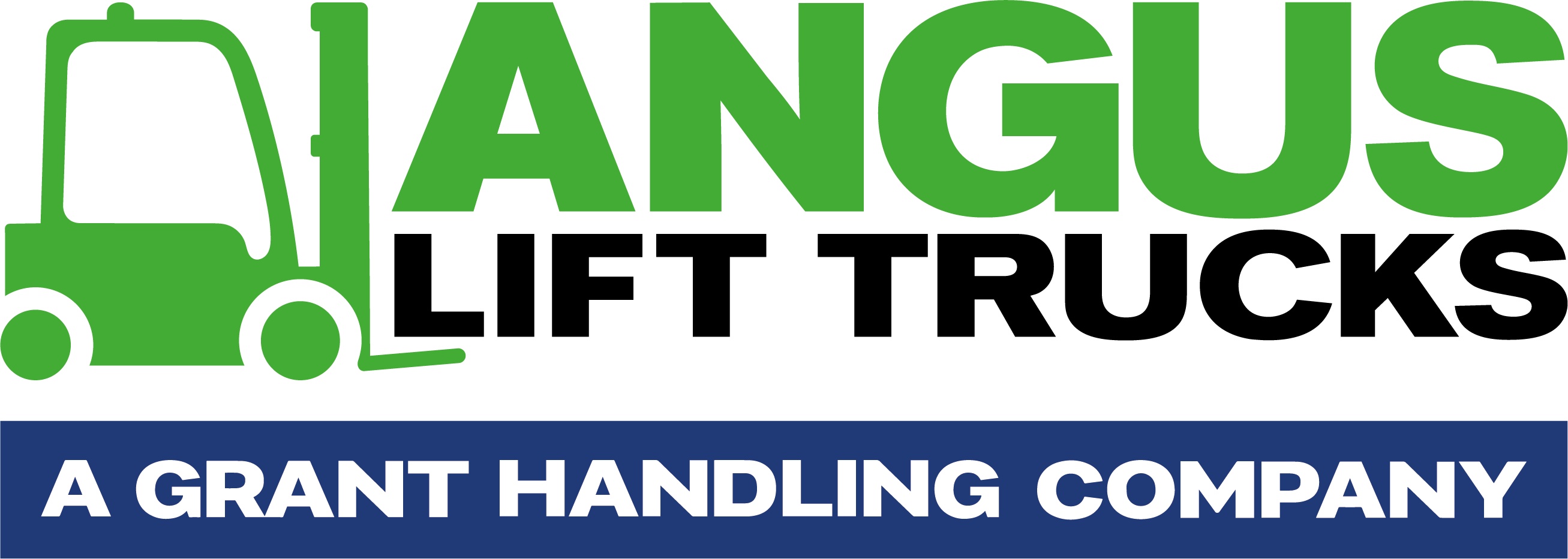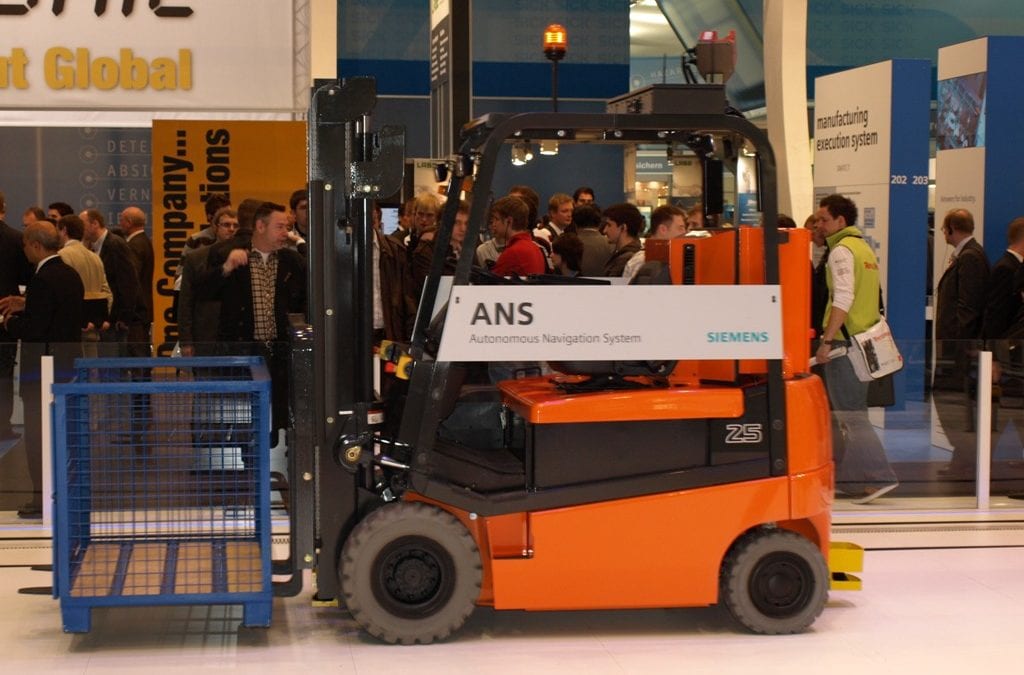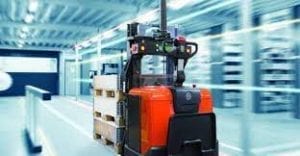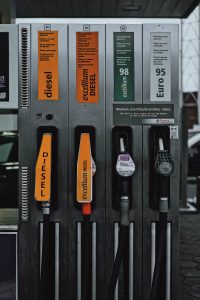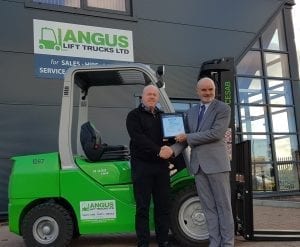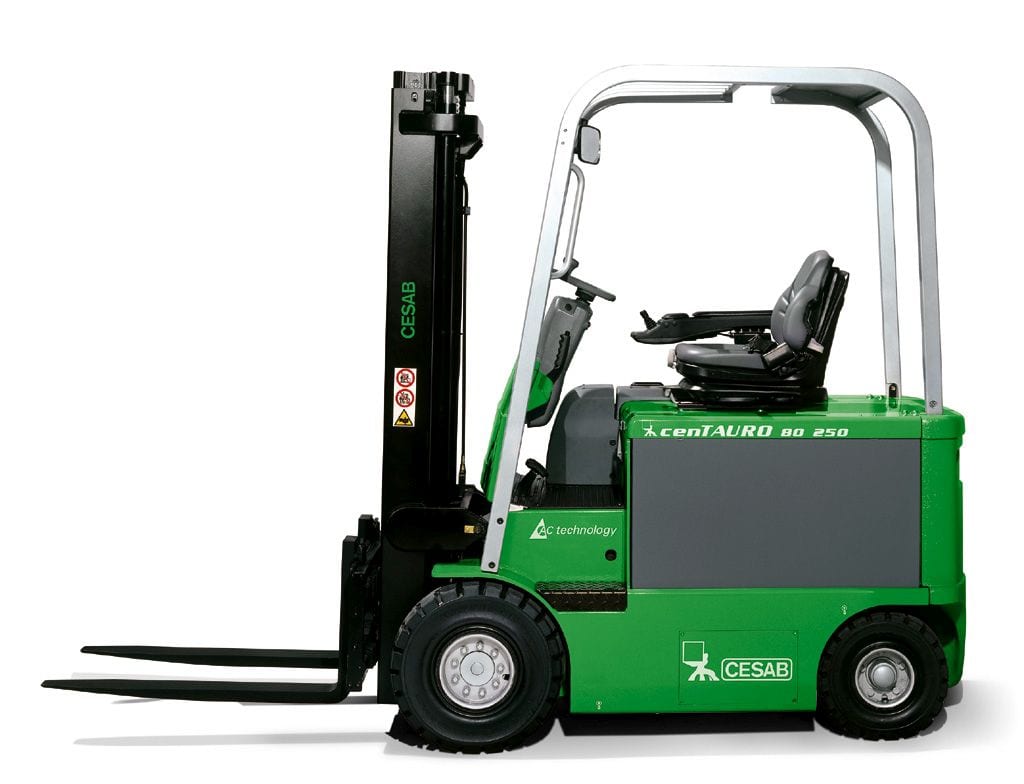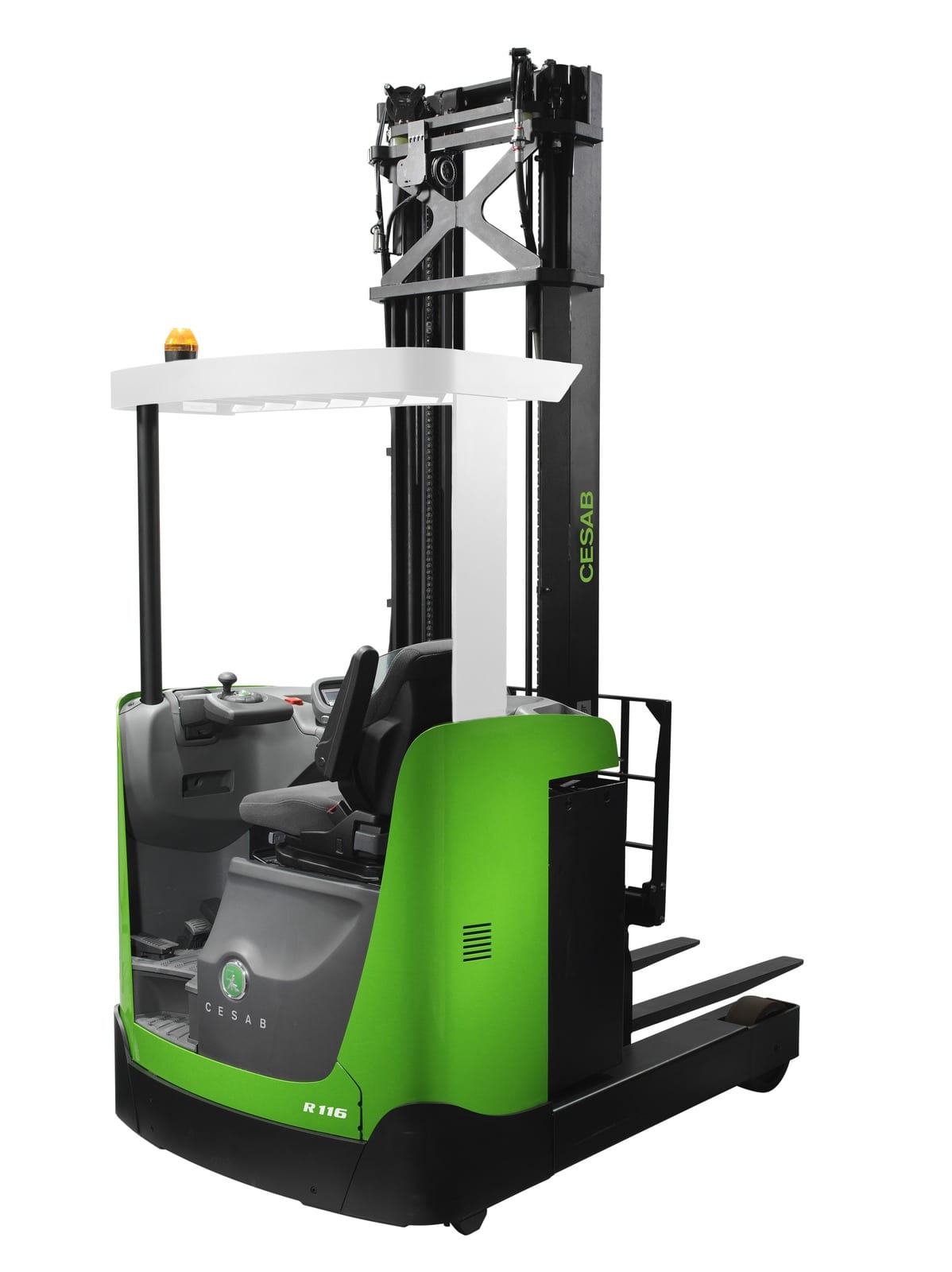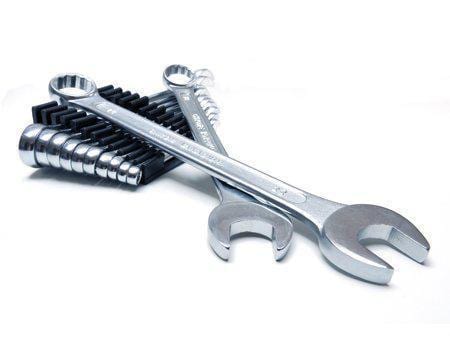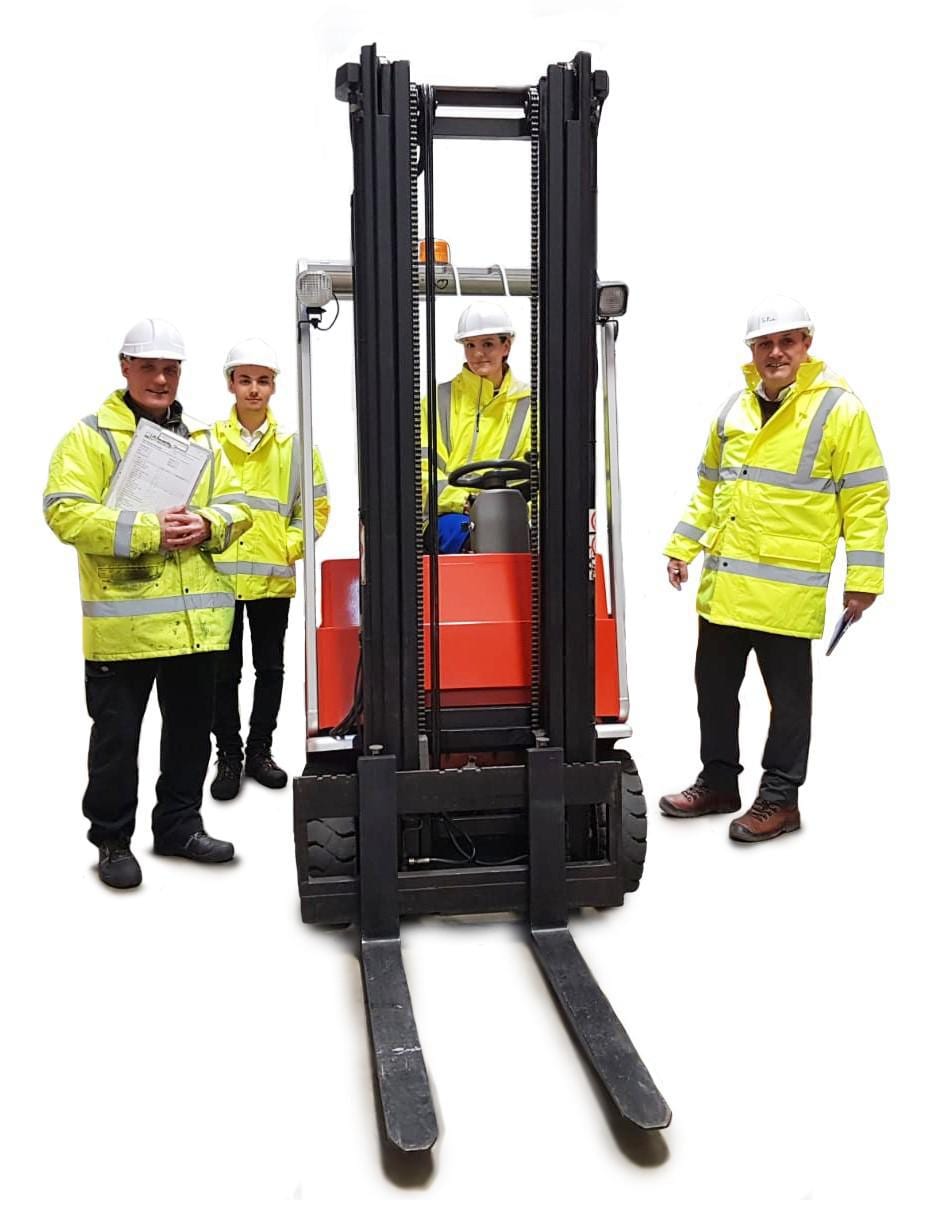Technology moves quickly and touches nearly every industry in the world. Keeping up with the latest technology helps businesses stay competitive. To that end, in this article, the team at Angus Lift Trucks examines the top five trends in tech and explores how they will transform the forklift industry.
Start by listening to our podcast episode on the emerging technologies that are already changing forck truck industry (and how they will continue to transform it in the future):
You can also watch our short video overview:
1. Impact of Automation on Forklift Industry
Automation isn’t exactly new to the shipping and distribution industry. The implementation of the transfer machine in 1888 was the first automation landmark; however, today’s technology is launching automation into a new era.
Forklift technology has given rise to several versions of automated machines for lifting and moving. Automated Lift Trucks (ALT) learn routes and tasks from an operator who drives the machine in “learning” mode. They can then switch to automatic mode and drive themselves.
Automated Guided Vehicles (AGV) do not require an operator. They use cameras, lasers, and floor markings to navigate. AGV forklifts can perform pallet racking, gravity racking, mobile racking, drive-in racking, block-stacking, and more.
Autonomous Mobile Robots (AMR) are the most advanced of the three. They don’t require an operator or guide markings. Instead, they use artificial intelligence (AI) to learn about their environment and make adjustments accordingly.
The most well-known example of AGVs in use now is Amazon’s fleet of orange drive robots that can move a 340 kg rack of product across a warehouse floor at 5.5 km/hr.
Human “stowers” unpack goods and place them in bins on a tall yellow pod. The robots then move the pod either to a waiting position in the warehouse or to a “picker” station. A human picker takes items from the bins to pack for consumers.
Far from eliminating jobs, Amazon says implementing robots has created hundreds of thousands of them. Employment-reporting site Glassdoor currently shows over 2k open jobs for Amazon in the UK.
It’s easy to see why forklift fleet automation is attractive to companies. These machines can work 24/7, don’t need medical or dental benefits, and are faster and more accurate than human employees. Although autonomous forklifts are expensive, they quickly pay for themselves.
Utilizing automation within the materials handling equipment environment is one method companies are advancing and adapting to modern technology and practical business tools. It can help save organizations thousands on overhead costs, minimize work-related accidents and enhance productivity.
Current market trends for automated forklift trucks project to increase to over USD 786 million by 2026 gradually. This figure comes from analyzing the compound annual growth rate (CAGR) of 8.3% currently in place for the forklift industry. Many believe this is on track with how businesses are heading in the future.
Warehouses are becoming modernized in their practices and require more horizontal and lateral material management. With smaller or more frequent orders, the need for forklift automation is essential to keep the business operational. In addition, using this autonomous forklift equipment in the workplace ensures less time lost from accidents, such as tipping over or carrying unbalanced loads.
Rather than taking away jobs from people, automated forklift trucks can fill in the employment gaps to eliminate having certified operators complete the monotonous duties. Companies can use staffing resources in areas where human interaction is necessary rather than tedious warehouse material management.
Although forklift automation may seem like the ideal solution for many workplace environments, they are not without their drawbacks.
AI forklifts also need fuel, space, repair, and guidance. Human operators will still be needed to help teach ALTs and drive 5G remote forklifts. As of yet, the automated forklift fleet can’t detect things like product spills or work on uneven floors.
When working outdoors, automated forklifts need to withstand weather, dirt, and wear. There are currently AGVs that operate outside of the controlled conditions of a warehouse. They are typically used to take materials between facilities on the same lot.
Automated forklifts aren’t likely to replace workers on a large scale anytime soon. Instead, they take on the more boring, repetitive tasks to free up workers for more nuanced work. Developers and designers are looking to the future with an eye on how forklifts can work safely with humans rather than replace them.
Listen to our Podcast Episode:
2. Impact of AI on Forklift Industry
Artificial Intelligence (AI) is growing by leaps and bounds since it was first presented at a conference in 1956. Since then, components have become smaller, more efficient, and more affordable. Computing technology has improved at a mind-blowing pace.
AI is being integrated with AMRs to make them more adaptive to working with people. They can detect traffic patterns in a warehouse and learn to avoid high traffic areas. They can learn and choose the most efficient routes to get from point A to point B.
AMRs can do all this without relying on wires or ground markers. That means they can be deployed immediately without extensive modification to the workspace. They’re more flexible and adaptable than either AGVs or ALTs.
AI seems to be the next stage in forklift automation for major suppliers. Currently, the world’s largest maker of forklift trucks, Toyota, is working on four AI development projects. They plan to introduce a pallet drone, mid-lifter, ultra-lifter, and a fleet of drivers similar to Amazon’s orange AGVs called “swarm.”
This is a step up from their “smart trucks,” which have been in production since 2018. Like the smart forklift trucks, the new generation of vehicles will produce data on efficiency, shock monitoring, and performance. Managers can then use this information to streamline their operations and improve risk assessment.
AI forklifts will also help to prevent accidents. Each year, around 1000 work-related injuries are reported to the HSA. The majority of those come from the agriculture, construction, transportation, and storage sector. This doesn’t include the dozen or so annual fatalities.
AI is supposed to reduce those numbers. Equipped with adaptive intelligence technologies, proximity warnings, and faster than human-reaction-times, AI forklifts can respond more quickly to potential dangers.
Moreover, autonomous AI forklifts are ideal for working in tight spaces where traditional manned forklifts will not fit. Compact warehouses with a lack of square footage or workable area do not pose any issues for AI forklift trucks.
The possibility for error is minimal when integrating AI technology into a material handling equipment setting. Excessive speed and operator fatigue are virtually eliminated with AI forklifts, helping to minimize workplace accidents and injuries overall. In addition, the cost savings on reducing downtime and user errors can be significant over time.
AI forklifts can also work with hazardous materials or extreme environmental conditions that pose a threat to flesh and blood workers. Then there’s the simple matter of not having as many people on the warehouse floor.
The ability for AI forklifts to take over potentially dangerous tasks or help to reduce staffing injuries or deaths is well worth the price tag for many organizations. Organizations can continue shipping products even in extreme weather conditions or a reduction of staff during off-peak hours. The question is not if they will appear in the workplace, but when.
Right now, AI forklifts aren’t widespread. They’re expensive, need more testing, and could use an extensive PR outreach campaign. Finally, automated forklifts are sometimes approached with suspicion by workers.
To gain more acceptance, workers and managers have to be educated. They need to learn how to interact with autonomous AI forklifts, their capabilities and view them as tools rather than competition.
Rest assured, AI forklifts are coming and coming soon. However, they won’t immediately replace their human counterparts. As advanced as autonomous forklifts are, they lack the interpretive abilities of the human mind. AI forklifts also need fueling, repairs, and other maintenance that they can’t perform on their own.
Because of these restrictions, AI forklifts will still require human workers to be present. Even the best AI technology cannot entirely replace a warehouse full of staff. If anything, more jobs will come from the continuous maintenance and repairs these AI forklifts will need with regular use and as they age.
Unlike AGVs, AI-equipped trucks don’t require a system of markers to get around. So, if they’re put to work outdoors, there’s no need to install that infrastructure first. As with the other vehicles, AI forklift trucks will need modification to handle outdoor conditions.
Looking to Buy or Hire

a forklift?
With 35+ years of experience, we offer our most competitive rates, flexible finance, 4h service promise & more!
3. The Impact of 5G in the Forklift Industry
The world’s fifth-generation mobile network, or 5G, saw its first implementation in 2019. The four major players in the UK’s telecom industry have now all launched their 5G networks around Europe. EE was the first to lead the pack and currently has more coverage than O2, Vodafone, and Three UK. According to EE, they’re now connected in 160 towns and cities.
5G boasts much faster speeds than its predecessor, 4G. It also has higher capacity, less latency, is more unified, and better utilizes resources. The bad news is that you’ll need a new device to connect to the new system.
At first blush, one might associate 5G with cell phones and not much else. However, 5G will be a prime player in the “Internet of Things” (covered in the next section). The way it plays out in the warehouse environment is by enhancing connectivity.
As technology advances in the workplace, an organization’s machines and tools are only as effective as its limits. Automated forklifts, conveyor belts, cameras, and other digital devices need a way to communicate with each other to be efficient and productive. This element is where the 5G network can streamline company processes and production tasks.
Warehouse managers can schedule tasks such as predictive maintenance and repairs with real-time feedback from AI forklifts on the 5G network. Handling potential problems before they occur is just one cost-saving measure of this technological advancement in the management of forklift fleets.
Not only will this network modernize the workplace, but it can also open up opportunities that were never possible before now.
5G will enable operators to control forklifts remotely. So, forklift drivers can avoid the hazards of interacting with heavy equipment, oversized loads, and extreme temperatures. Like many office workers, forklift drivers would be able to work from home.
Switching to a 5G network can create jobs in organizations where the updated equipment is necessary before full implementation. Companies will require skilled workers to install the system so that all digital equipment is compatible and talks seamlessly to each piece when active.
Global logistics provider Geodis partnered with software company Phantom Auto to recently complete their first successful remote operation of a forklift. The vehicle was physically located in France but controlled by an operator in California.
The company says remote operation will open the forklift industry up to a more diverse workplace, inclusive of women and the disabled. One forklift driver can also pilot different machines in different locations in the same workday.
Thailand has also conducted a successful remote forklift operation over the 5G network. The forklift was located in Saraburi while the driver was sitting in Bangkok, 110 kilometers away. They were able to operate the forklift in real-time and fluidly move palettes from A to B.
The test is encouraging. Future implementation could lead to remote forklift operator training, socially distanced working, and increase the country’s competitiveness in the forklift industry. 5G is crucial because its fast speed and large data capacity allow a smooth connection between the forklift operator and the machine.
The limitation of 5G capable devices is that they rely on the ability to connect to a 5G network. Any company hoping to implement this technology in their warehouses will have to be located somewhere that gets a strong signal. This also makes them prone to interruption if the network is down or has trouble.
Infrastructure for 5G is rapidly improving, with signal towers going up everywhere. Still, unless there are enough towers nearby to provide a signal reliably, minor weather events could disrupt forklift operations.
As advanced as 5G environments are, any interference can hinder productivity and create efficiency issues. These problems can cost a company potential profits from unforeseen downtime. It can also leave workers present in the warehouse unable to operate forklift equipment manually during these outages, costing more organizational losses.
Facilities located in rural areas might not yet have the towers they need to remote pilot a fleet of forklifts. Until either infrastructure or technology catches up, the broad adaptation of 5G in a distribution setting could be slow.
Major companies like Toyota, Geodis, Linde, CESAB, and Hyster can make all of the AI forklifts they may decide to. However, unless the infrastructure exists, these types of forklifts won’t make much of a difference in the industry.
4. The impact of IoT in the Forklift Industry
The “Internet of Things” is a term that’s been around for a while. It refers to objects that can connect to the internet. That includes smartwatches, TVs, surveillance systems, kitchen appliances, toys, and cars.
Most of the time, these digital “things” collect data about the user and upload that information to various entities. They also provide convenience to the user. A fitness band gathers data on how many calories the wearer burns in a day. This information can help the wearer to decide to reduce inactivity or limit food intake.
Advertisers can also use the information. If the band senses the wearer going for a jog every morning, they might receive ads for jogging shoes in their email. The band might also send information about the wearer’s morning route.
The Internet of Things can also refer to things in a closed system. It could be a home security system that connects cameras, motion sensors, and doorbells to the user’s phone. The individual devices communicate with each other and the user only.
In the warehouse, one example of IoT tech is Palletech’s smart pallets. A central plank has several sensors that send data to the cloud. Managers can then use their computers or phones to keep up with shipments.
Palletech’s central plank can send data such as the temperature, the pallet’s location, and how efficient routes and handling are. Users can see where a shipment is on a map in real-time. Recovering a stray pallet is as easy as turning on a computer.
Temperature and timeliness are particularly important in the food industry supply chain. Smart devices like Palletech’s planks can let a manager know if food is in danger of spoiling. They can also help pinpoint arrival times so receiving departments can streamline schedules.
Currently, the most widely used IoT technology in supply chain management is RFID tags. These tags contain a circuit and an antenna that transmits information to an RFID reader. Consider it a step up from barcode scanning.
Unlike barcoding, RFID tags don’t need a direct visual connection to transmit their information. Companies can use tags to track inventory, control access, prevent counterfeiting, and track personnel. RFID tags don’t smear or tear and can’t be marked out.
Combine IoT with 5G and AI, and you get a technology trifecta that boosts productivity exponentially. The possibilities here are endless. Consider a warehouse with a fleet of AI forklifts, pallets, and other materials handling equipment.
The AI forklifts gather and process data as they work. They can share that data to coordinate more efficient routes. That data gets processed and sent to warehouse managers via the 5G network. Managers can then implement changes in real-time.
The more integrated these three technologies become, the more reliant they will be on each other. For the system to excel, the 5G signal has to be strong and reliable. Forklifts with AI have to be supported by their human coworkers. Companies have to understand their current workflows and identify where the new technology serves them best.
While autonomous forklifts may seem like a dream come true for many organizations, it does not come without its challenges. The warehouse manager and staff on hand must know how to operate AI forklift equipment and use the gathered information appropriately. Real-time data can help workers define gaps in productivity and refine daily processes.
Advancements in the workplace can make staff nervous, but the idea of futuristic forklifts and materials handling equipment completing daily tasks is not as threatening as some may believe. IoT will not be the all-encompassing process that replaces humans due to several elements.
Companies will need to put staff in roles that oversee their digital technology to ensure smooth operations of AI forklift equipment at all times. Any disruptions or miscommunications with 5G networks, AI machines, and automated forklifts can cost an organization thousands in profits if there is no one on hand to remedy the situation quickly and effectively.
While IoT digital technology may replace some tedious labor-intensive work tasks in the warehouse, workers will still be essential in daily operations. In fact, many warehouses may require additional staff who possess proper training and knowledge of the digital systems to intervene if any issues arise.
5. The impact of Fuel Technology advances in the Forklift Industry
Present-day forklifts use one of three fuel sources: diesel, batteries, or liquified petroleum gas (LPG). Diesel produces exhaust and requires areas with inadequate ventilation while batteries take up valuable warehouse storage space. LPG consumes fossil fuels.
Consequently, more organizations are aware of their carbon footprint and how their business operations affect the environment. Energy and fuel are the main products for production and are continuously scrutinized, especially in warehouses that use heavy equipment like forklifts.
The next advancement in fuel technology for forklifts lies in hydrogen. Hydrogen fuel cells can be used to power forklifts, lift trucks, tractors, and cars. The hydrogen fuel vehicles recharge at a station just like a diesel vehicle would. Companies can install refueling stations inside the warehouse so machines can get back to work quickly.
Hydrogen fuel cells can ensure business operations can resume without operator downtime by taking only minutes to refuel and avoid production gaps. All around, hydrogen fuel cells look to be a better cost-effective choice for man-driven forklifts in a warehouse setting.
Companies that seek a more environmentally-friendly alternative to warehouse material management are looking to hydrogen fuel cells.
Unlike diesel, the only byproduct of hydrogen is water. For those countries aiming to reduce their impact on the climate, hydrogen is a safe choice. While most hydrogen comes from natural gas extraction, agricultural and waste sources also exist.
Unfortunately, these factors can hinder the collection, transportation, and storage of vast amounts of hydrogen in many areas around the world.
The energy provided by hydrogen fuel is impressive. Compared to gasoline, it’s almost three times the power. One kilo of hydrogen contains as much energy as 2.8 kilos of gasoline. Hydrogen-powered engines don’t expel toxic fumes and don’t need workers to refuel them as often as gasoline.
Compared with electricity-powered vehicles, hydrogen goes the distance. While an electric car can typically drive for 160-320 km without recharging, a hydrogen vehicle can go nearly 500 km. They also recharge faster, in about five minutes.
Gasoline freezes at around -73 ℃ while hydrogen’s freezing point is near -250 ℃. This lower freezing point enables hydrogen-fueled vehicles to operate in colder conditions like industrial freezers.
For all of their advantages, hydrogen fuel cells remain the most expensive power option. This difference is mainly due to storage and availability concerns. While it’s not costly to produce, these concerns drive up the cost to the end-user.
Right now, about 500 hydrogen cell forklifts are in operation throughout Europe. Toyota, Linde, Hyster-Yale, STILL GmbH, and Hydrogenics are among the world’s top manufacturers. That number is likely to jump as the technology becomes more available, and organizations can fiscally implement these advancements.
At the moment, only large corporations like Amazon and ASDA can afford to implement hydrogen. Smaller warehouses and independent distributors will have to wait until the cost comes down.
In a warehouse setting, hydrogen fuel cell vehicles translate to better working conditions and less downtime. PlugPower, one producer of hydrogen fuel cells, claims they lower operational costs by 84% compared with combustion generators.
This technology is probably the least likely of the five listed to put forklift drivers out of a job. Those vehicles in operation now are driven the traditional way. However, combined with AI and other automation, supply chain managers can increase productivity by operating 24/7.
Manual operators will still be in demand for completing warehouse duties where this heavy equipment is necessary. In fact, organizations may need more warehouse staff if production becomes more efficient and business operations increase due to less downtime.
Hydrogen fuel cells can easily integrate within the standard forklifts that are in use today, making the switch easy for companies who can afford the up-front costs of the transition.
Looking to Buy or Hire

a forklift?
With 35+ years of experience, we offer our most competitive rates, flexible finance, 4h service promise & more!
6. The Impact of Telematics in the Forklift Industry
Telematics will impact the future of forklift trucks and material handling in a number of different ways, including increasing safety, energy optimization, and regulatory compliance. What’s more, it will also reduce operational costs and provide access to other exciting opportunities.
Telematics — which means telecommunications and informatics — describes a technology that allows remote vehicles to communicate over long-distance networks. In other words, it allows teams to install sensors on their forklift and use enterprise resource planning (ERP) tools to track fleet management.
While tracking your forklifts is an important part of inventory management, telematics offers far more sophistication than knowing where your machinery is at all times. Instead, telematics is about monitoring the performance of your forklifts and finding ways to get the most out of your investment.
The exciting thing about this technology is that it sends and receives data to a centralized hub, giving unprecedented insights into how and where forklift trucks are used within your organization. The implications are significant because analyzing this data will improve the overall safety, efficiency, and understanding of material handling.
Some of the data that you can collect with Telematics include data on who is operating the forklift, what speed it is traveling at, where it is in the warehouse, and how much fuel it is using. Additionally, it can also track things like acceleration and brake times. This data is invaluable in making your warehouse safer and also provides key information if accidents do occur.
With warehouse operations facing increased regulatory compliance pressures, telematics will provide real-time, up-to-the-minute audits. These systems can also help with a variety of reporting requirements, including the recording of maintenance schedules and checks designed to ensure safety at all times.
Of course, safety is just one of the many benefits that you can unlock with Telemetrics. The information can also be crunched by ML tools to identify inefficiencies and bottlenecks. With warehouse automation around the corner, this data can provide a source of best practices to teach machines while also allowing organizations to run impact reports across a variety of scenarios.
Understanding route paths will be essential in large warehouse operations. Optimizing these pathways will ensure the machines are used optimally in terms of both time and fuel expenditure. Telematics can also be used in conjunction with ML for predictive maintenance and repairs, which will be invaluable in reducing the operation costs and downtime of forklift investments.
Finally, telematics will allow for advanced sustainability. As mentioned earlier, the technology will allow teams to reduce forklift trucks’ fuel and battery consumption and the factory’s overall CO2 emissions through greater efficiency.
In short, the more data your warehouse has, the better decisions you can make. Always-on records of your forklift trucks will provide incredible visibility of processes. When paired with ML analytics and the inevitable rise of automated forklift trucks, the future of a connected, self-running warehouse is just around the corner. Throw on top of that a greener operation with reduced accidents, and it’s clear why telematics will become a big part of the material handling business in the next few years.
Trends you need to know about to keep your business in the competitive loop.
Earlier this month, industry leader Angus Lift Trucks released a memo about the technology trends creating a mass evolution in the forklift industry. Each of these technologies will streamline the tasks of companies and keep their workers safe. Despite widespread concern about technologies like automation and AI making the human workforce redundant, Adam Lantsbery, Commercial Director at Angus Lift Trucks, assures that “these technologies are changing the forklift industry for the better.”
Around five people receive life-changing injuries from forklift accidents every day in the UK, with trends showing an increase in fatalities in recent years. It is increasingly imperative that we utilize emerging technologies to innovate the forklift industry.
Angus Lift Trucks’ review of five transformative technologies shows that automation can improve the safety of forklifts without replacing workers. Automated Lift Trucks (ALTs) receive training from operators, who then step aside and monitor the forklifts at a safe distance.
Automation is already in place in other industries. For instance, automated guided vehicles (AGVs) are widely used at Amazon, creating 300,000 new jobs. Autonomous mobile robots (AMRs), like Google’s automated cars, utilize artificial intelligence to gather knowledge about their surroundings and make changes as needed.
Adam Lantsbery believes that implementing these technologies in the forklift industry can open jobs, reduce costs, improve efficiency, and keep companies up-to-date on market trends. Furthermore, ALTs will place people in more meaningful jobs that eschew monotonous tasks for human interaction.
Another vital technology detailed by Angus Lift Trucks is artificial intelligence. “Artificial intelligence will revolutionize the forklift industry,” Lantsbery says. AMRs and AI forklifts can detect traffic patterns, choose efficient routes, and work in spaces that humans cannot.
AI forklifts can reduce work-related injuries and fatalities, boost efficiency and productivity, and assist human workers. Also, they can work in tight spaces or with hazardous materials in dangerous conditions without threatening human life.
You may not think about it, but Adam Lantsbery pointed out how 5G can also change how we use forklifts. By accelerating technology speeds, 5G devices can enhance the connectivity of warehouse workers.
Angus Lift Trucks believes that 5G will aid in remote-controlled forklifts, enhanced safety, and workplace comfort. While forklift operation is typically viewed as a job that must be performed in-person, 5G and automation technologies make working from home a possibility.
Imagine a world where construction workers don’t need hard hats! Adam Lantsbery knows it’s possible, and it’s coming soon. Linde, Toyota, CESAB, Hyster, and Geodis have all integrated AI forklifts with remote operations in their companies. Soon, it will be commonplace.
5G connects to the Internet of Things (IoT), which includes all objects with an internet connection. Supply chain management and warehouses have already seen the use of Palletech’s smart pallets and RFID tags to track shipments and inventory while preventing fraud.
According to Adam Lantsbery, the future involves AI forklifts operated remotely using 5G and working with smart pallets. By further integrating these technologies, companies can optimize their use of these technologies to create a safer workplace environment.
The last technology covered in this must-read memo concerns fuel. Forklift operation power or fuel technology is essential to the operation of forklifts. Due to the environmental and quantitative drawbacks of these resources, an emerging fuel may transform the forklift industry – hydrogen fuel cells.
Hydrogen is efficient, safe, fume-free, and zero-carbon. It improves the productivity of forklifts without being detrimental to the health of workers or the environment. Hydrogen fuel is the next big thing in vehicular power.
Angus Lift Trucks dives much deeper into each of these technologies to see how they will innovate the forklift industry. We believe that everyone should read this post to learn what the future will look like.
Final Thoughts
What does all of this new technology mean for forklift drivers? Once they’re fully in place, the innovations could lead to a more efficient workplace, higher productivity, increased driver safety, and remote work opportunities.
Peripheral tasks like unloading trucks, fueling machines, and packing will still need to be done by human hands. Automation is good with repetitive tasks but hasn’t yet evolved for more nuanced work and high-level decision-making.
It also means that drivers will have to adapt to working with AI machines. These advances are coming, whether or not drivers want them. The faster drivers learn to see them as valuable tools, the more they can successfully utilize them.
The technologies above are changing the distribution world and will bring the industry into a new era.
You may also like
About Angus Lift Trucks LTD
Angus Lift Trucks LTD is a notably large and successful independent dealership of forklifts, floor care equipment, and access platforms. They have received the national certificate of compliance from the Forklift Truck Association FLTA. The company prides itself on high-quality customer service and its practical training and development strategy.
Trainers at Angus Lift Trucks provide forklift operation training in the following areas: Birmingham, Derbyshire, East & West Midlands, Leicestershire, Nottinghamshire, and Northamptonshire.
Angus Lift Trucks is the go-to-vender for learning how to embrace the changing landscape of forklift operation. Whether you read their blog to learn more about the industry or utilize their services, you should visit their website for all things forklifts.
Until then, if you require to service, buy, or hire forklifts for your projects across the Midlands, Angus Lift Trucks has over 35 Years of Experience in renting forklifts in Leicestershire, Nottinghamshire, Northamptonshire, Birmingham, Warwickshire, Derbyshire, East Midlands & West Midlands.
This post is also available in:
Français
Deutsch
Italiano
Português
Español
Български
Hrvatski
Eesti
Latviešu
Lietuvių
Polski
Português
Русский
Slovenčina
Slovenščina
Türkçe
Українська
Albanian
Čeština
Dansk
Nederlands
Ελληνικά
Magyar
Română
